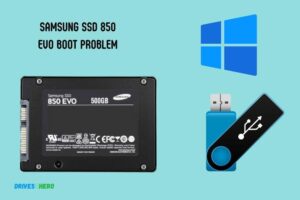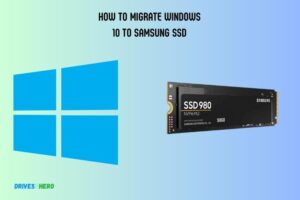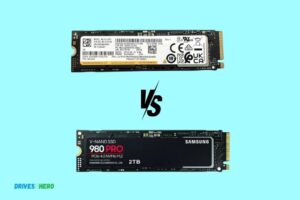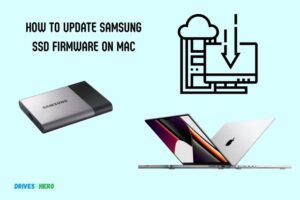Ssd Samsung Vs Crucial Vs Sandisk: Which One Is Superior?
Choosing between SSDs from Samsung, Crucial, and SanDisk involves considering various factors to meet specific performance and budget requirements.
Samsung SSDs, renowned for their reliability and speed, often feature cutting-edge technologies like V-NAND, ensuring optimal data transfer rates and durability.
Crucial, a brand by Micron, offers a balance of performance and affordability, with SSDs like the Crucial MX500 providing reliable speeds and good value for money.
SanDisk, known for its diverse storage solutions, delivers SSDs suitable for a range of applications, with an emphasis on storage capacity and overall value.
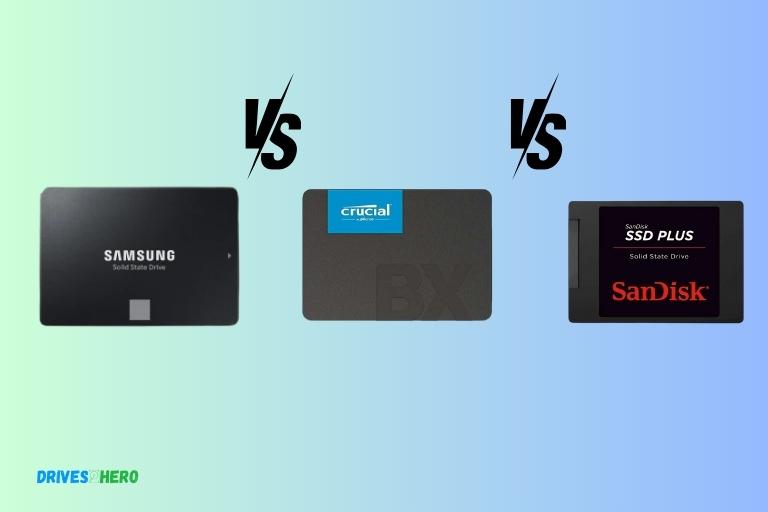
Key Takeaway
9 Features Of Ssd Samsung Vs Crucial Vs Sandisk SSD
| Feature | Samsung SSD | Crucial SSD | SanDisk SSD |
|---|---|---|---|
| Model | Samsung 970 EVO Plus | Crucial MX500 | SanDisk Ultra 3D |
| Capacity Options | 250GB, 500GB, 1TB, 2TB | 250GB, 500GB, 1TB, 2TB, 4TB | 250GB, 500GB, 1TB, 2TB, 4TB |
| Interface | NVMe (PCIe Gen 3.0 x4) | SATA 6.0Gb/s | SATA 6.0Gb/s |
| Sequential Read (up to) | 3,500 MB/s | 560 MB/s | 560 MB/s |
| Sequential Write (up to) | 3,300 MB/s | 510 MB/s | 530 MB/s |
| Random Read (up to) | 600,000 IOPS | 95,000 IOPS | 95,000 IOPS |
| Random Write (up to) | 550,000 IOPS | 90,000 IOPS | 84,000 IOPS |
| Form Factor | M.2 (2280) | 2.5-inch and M.2 (2280) | 2.5-inch |
| Warranty | 5 years or up to 600 TBW | 5 years | 3 years or up to 400 TBW |
Performance Comparison: Speed And Reliability
Samsung, Crucial, and Sandisk SSDs are compared for their speed and reliability in this performance comparison. Choose the best option for your needs.
Ssd Speed Rankings: Samsung, Crucial, Sandisk
Samsung, Crucial, and Sandisk are well-known brands in the world of SSDs (Solid State Drives). When it comes to performance, speed, and reliability, each brand has its own strengths and weaknesses.
Factors Affecting Ssd Speed And Reliability
Several factors play a key role in determining the speed and reliability of an SSD.
These factors include:
- NAND Flash Technology: The type and quality of NAND flash memory used in an SSD greatly impact its speed and reliability. Samsung, Crucial, and Sandisk each use different types of NAND flash technology in their SSDs, resulting in variations in performance.
- Controller: The controller is like the brain of an SSD, responsible for managing data, read and write operations, and overall performance. The efficiency and capabilities of the controller significantly contribute to the speed and reliability of the SSD.
- Interface: The interface through which the SSD connects to the computer also affects its speed. The most common interfaces include SATA, PCIe, and NVMe. The newer PCIe and NVMe interfaces offer faster transfer speeds compared to the traditional SATA interface.
- Cache: The presence of a cache, typically DRAM or SLC, helps improve an SSD’s performance by temporarily storing frequently accessed data. A larger cache size can enhance speed and reduce latency.
- Overprovisioning: Overprovisioning involves allocating a certain amount of the SSD’s overall storage capacity for internal use. This reserved space improves performance and prolongs the SSD’s lifespan.
Real-World Performance Tests And Benchmarks
To assess the speed and reliability of SSDs, real-world performance tests and benchmarks are conducted.
These tests simulate common usage scenarios to measure how well an SSD performs. Several factors come into play during these tests, including:
- Sequential Read and Write Speeds: This test measures the transfer speed of large continuous files. Higher sequential read and write speeds indicate better performance and faster data transfer rates.
- Random Read and Write Speeds: Random read and write speeds are crucial for day-to-day computing tasks, such as opening applications and accessing files. SSDs with high random read and write speeds exhibit faster response times, resulting in smoother overall performance.
- IOPS (Input/Output Operations Per Second): IOPS measures the number of input/output operations an SSD can perform in a second. Higher IOPS values imply better performance in multitasking scenarios and heavy workloads.
- Durability and Endurance: SSD endurance is assessed through tests that simulate continuous read and write operations over an extended period. Higher endurance ratings ensure reliability and longevity.
- Power Efficiency: Power efficiency is evaluated by measuring the power consumption of an SSD during various operating conditions. SSDs with low power consumption optimize battery life in laptops and reduce energy costs in desktop systems.
By comparing these real-world performance tests and benchmarks, we can gain a better understanding of how Samsung, Crucial, and Sandisk SSDs stack up against each other in terms of speed and reliability.
Remember, understanding the SSD speed rankings and the factors that influence SSD performance can help you make an informed decision when choosing the right SSD for your needs.
Storage Capacities And Price Comparison
Compare storage capacities and prices of Samsung, Crucial, and Sandisk SSDs. Find the perfect solution for your needs with our comprehensive analysis.
Available Storage Capacities For Samsung, Crucial, And Sandisk Ssds:
Samsung SSDs: Samsung offers a wide range of SSDs with varying storage capacities to suit different needs and preferences.
Their options include:
- 250GB: Ideal for users with moderate storage requirements, such as casual gamers and web surfers.
- 500GB: A popular choice for everyday use, perfect for storing files, photos, and videos.
- 1TB: Provides ample space for power users, content creators, and gamers who require a larger storage capacity.
- 2TB and above: Samsung also offers high-capacity SSDs for professionals and enthusiasts who demand extensive storage for media production or heavy data workloads.
Crucial SSDs:
Crucial offers a range of SSDs with reliable performance and different storage capacities, including:
- 120GB: Suitable for users with basic storage needs, allowing for quick boot-up and efficient file management.
- 240GB: Offers a bit more storage space for users who require extra room for their files and applications.
- 480GB: Provides a substantial amount of storage for users who deal with larger multimedia files and extensive software installations.
- 1TB and above: Crucial also caters to those who require higher storage capacities, ensuring ample space for demanding tasks.
Sandisk SSDs: Sandisk offers a diverse lineup of SSDs, ensuring there’s an option for everyone.
Their storage capacity options include:
- 250GB: Perfect for users who primarily use their computers for web browsing, light document editing, and casual multimedia consumption.
- 500GB: Offers a balanced storage capacity for users who require a mix of everyday tasks and occasional heavier workloads.
- 1TB: Provides ample space for users who deal with large files, such as HD video and high-resolution images.
- 2TB and above: Sandisk also caters to professionals and content creators with a need for expansive storage to handle heavy workloads.
Price Range And Value For Money Comparison:
When considering the price and value for money of SSDs, it’s important to evaluate the storage capacity they offer to their cost.
Here’s a breakdown of the price range and value-for-money comparison for Samsung, Crucial, and Sandisk SSDs:
Samsung:
- Samsung SSDs generally fall within a higher price range compared to other brands. However, their reputation for reliability and performance justifies the cost, making them a great value for money investment in the long run.
Crucial:
- Crucial SSDs tend to offer a good balance between price and performance. They provide competitive prices for their storage capacities, making them an attractive option for budget-conscious consumers.
Sandisk:
- Sandisk SSDs often provide affordable options for those on a tighter budget. While they may not have the same level of performance as the higher-end brands, they still offer good value for money, particularly for users with more moderate storage needs.
Factors To Consider When Choosing The Right Storage Capacity:
When deciding on the appropriate storage capacity for your SSD, there are a few factors to consider:
- Usage requirements: Assess your needs and determine the amount of storage required for your specific use case, such as gaming, content creation, or everyday tasks.
- Budget constraints: Take into account your budget and find a balance between storage capacity and price that meets your requirements without breaking the bank.
- Future scalability: Consider any potential future storage needs, such as anticipated growth in data or the addition of new applications, to ensure the chosen capacity will accommodate future demands.
- Data management practices: Evaluate your data management habits, including regular backups, file organization, and data deletion, as these practices can help optimize your storage capacity.
By taking these factors into account, you can make an informed decision when choosing the right storage capacity for your SSD.
Understanding the available storage capacities and price range of Samsung, Crucial, and Sandisk SSDs is crucial when making a purchase decision.
Design And Durability: Which Brand Offers The Best Build Quality?
The build quality of SSDs from Samsung, Crucial, and Sandisk are widely compared for their design and durability. Users often seek the brand that offers the best performance and longevity, making it essential to analyze the build quality of these brands.
Aesthetics And Form Factor Comparison
When it comes to choosing an SSD (Solid State Drive), design and durability are important factors to consider.
Let’s take a closer look at how Samsung, Crucial, and Sandisk stack up against each other in terms of aesthetics and form factor:
Samsung: The Samsung SSDs are known for their sleek and modern designs. They often feature a slim profile with a metallic casing, giving them a premium look and feel. With different series and models available, Samsung offers a variety of form factors to suit different devices and requirements.
Crucial: While Crucial SSDs may not grab attention with flashy aesthetics, they excel in offering a clean and minimalist design.
Their focus is more on functionality rather than flashy looks. The form factors they offer are compact and well-suited for various devices such as laptops, desktops, and even gaming consoles.
Sandisk: Sandisk SSDs are designed with simplicity and practicality in mind. Their form factors are usually compact, making them easy to install in different devices. Sandisk focuses on providing a reliable and straightforward design that fits seamlessly into a range of systems.
Durability And Ruggedness Tests
Apart from aesthetics, durability is a crucial aspect when it comes to selecting an SSD.
Let’s see how Samsung, Crucial, and Sandisk perform in terms of durability and ruggedness:
- Samsung: Samsung SSDs are known for their durability. They go through various tests and come equipped with technologies like Dynamic Thermal Guard, which ensures optimal temperature management to enhance the drive’s lifespan and performance.
- Crucial: Crucial SSDs undergo rigorous testing to ensure durability. They are designed to handle shock, vibration, and temperature variations. With features like endurance ratings, Crucial SSDs offer reliable performance even in demanding conditions.
- Sandisk: Sandisk SSDs are built to be durable and rugged. They are engineered to handle shocks, vibrations, and temperature changes. These SSDs can withstand extreme operating conditions, making them suitable for various environments.
Warranty And Customer Support
Considering warranty and customer support is essential when making your SSD purchasing decision.
Let’s compare the offerings of Samsung, Crucial, and Sandisk in this regard:
- Samsung: Samsung offers a range of warranty options for their SSDs, varying by model. The warranty period typically ranges from three to five years, depending on the specific SSD. Samsung provides customer support, ensuring users can reach out for assistance if needed.
- Crucial: Crucial is known for its excellent warranty and customer support options. Most Crucial SSDs come with a five-year warranty, providing users with peace of mind. In case of any issues or queries, Crucial has a responsive customer support team available to assist users.
- Sandisk: Sandisk offers a warranty period that varies based on the SSD model. Typically, their SSDs come with a three-year warranty. Sandisk also provides reliable customer support, making it easy for users to access assistance and resolve any potential concerns.
When it comes to design and durability, Samsung, Crucial, and Sandisk each have their strengths. Samsung stands out with its sleek designs and proven durability, while Crucial focuses on functionality and ruggedness.
Which Ssd Brand Should You Choose?
Choosing the right SSD brand can be challenging. Samsung, Crucial, and Sandisk are popular options to consider. Each brand offers unique features and benefits, making the final verdict a matter of personal preference.
Consider factors such as storage capacity, speed, durability, and price to make an informed decision that suits your needs.
Factors To Consider Based On Your Specific Needs:
- Storage Capacity: The first aspect to consider when choosing an SSD brand is the storage capacity that suits your needs. Determine the amount of data you frequently access and select a brand that offers the right capacity.
- Performance: SSD performance is crucial for quick data access and smooth system performance. Consider factors like read and write speeds, as well as the overall performance ratings of the SSD brands.
- Reliability and Durability: Look for an SSD brand that is known for its reliability and durability. Check for features like high endurance, durability, and resistance to shocks and vibrations.
- Price: When choosing an SSD brand, consider your budget and find a balance between performance and cost. Compare the prices of Samsung, Crucial, and Sandisk SSDs to make an informed decision.
- Compatibility: Ensure that the SSD brand you choose is compatible with your system. Check the interface compatibility, such as SATA or NVMe, and the form factor of the SSD.
- Warranty: Pay attention to the warranty coverage offered by each brand. A longer warranty period implies the manufacturer’s confidence in the product’s quality.
- User Reviews: Reading reviews and feedback from other users can provide insights into the real-world performance and reliability of the SSD brands. Consider the overall user ratings and feedback before making a decision.
- Additional Features: Some SSD brands offer extra features such as data encryption, power loss protection, or built-in cache. Evaluate if these features align with your requirements.
Our Recommendation Based On Performance, Price, And User Reviews:
- In terms of performance, Samsung SSDs have consistently rated highly, offering exceptional read and write speeds.
- They are known for their reliability and durability, making them a popular choice among users. However, Samsung SSDs tend to be relatively higher in price compared to other brands.
- Crucial SSDs strike a good balance between performance and price. They provide solid performance ratings at a more affordable price point.
- Crucial receives positive user reviews, emphasizing their reliability and value for money.
Sandisk SSDs are another viable option, particularly for budget-conscious users. They offer competitive performance and reasonable prices.
Although they may not match the performance levels of Samsung or Crucial, Sandisk SSDs still provide a reliable and cost-effective solution.
Conclusion
Based on the comparison of SSDs from Samsung, Crucial, and Sandisk, it is clear that each brand offers distinct advantages and features.
Samsung SSDs are renowned for their high performance and reliability, making them ideal for demanding tasks such as gaming and content creation.
Crucial SSDs, on the other hand, focus on affordability without compromising on quality, making them a popular choice for budget-conscious users.
Sandisk SSDs strike a balance between performance and affordability, making them a versatile option for a wide range of users. The choice between these brands depends on individual needs and preferences.

